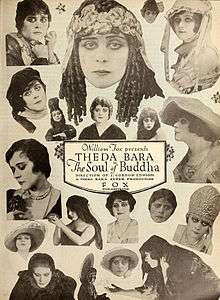The Soul of Buddha
The Soul of Buddha is a 1918 American silent romance film directed by J. Gordon Edwards and starring Theda Bara, who also wrote the film's story.[1] The film was produced by Fox Film Corporation and shot at the Fox Studio in Fort Lee, New Jersey.[2]
| The Soul of Buddha | |
|---|---|
 Advertisement | |
| Directed by | J. Gordon Edwards |
| Produced by | William Fox |
| Written by | Adrian Johnson |
| Story by | Theda Bara |
| Starring | Theda Bara Victor Kennard |
| Cinematography | John W. Boyle |
| Distributed by | Fox Film Corporation |
Release date |
|
Running time | 5 reels |
| Country | United States |
| Language | Silent (English intertitles) |
Plot
As described in a film magazine,[3] fascinated by the lure of white robes and dancing, Bava (Bara) enters the Temple of Buddha. She is soon disillusioned and, yielding to the entreaties of Major John Dare (Thompson) of the British army, she flees with him and becomes his wife, incurring the enmity of Ysora (Kennard), high priest from the temple. A child is born to the two but is later found dead with the Buddhist death mark on its forehead. This withers the soul of Bava, who leads her husband around the globe in search of happiness. Hardened by sorrow, she turns against Dare and bids him gone. At a Paris resort she meets a theatrical manager (Warwick) who is fascinated by her dancing. She accepts an offer to appear at his theater. At the night of her premiere her husband attempts a reconciliation, but is unsuccessful and kills himself in her dressing room. At the end of her dance Bava meets her death at the hands of Ysora.
Cast
- Theda Bara as Bava, the Priestess
- Victor Kennard as Ysora
- Florence Martin as Romaine's wife
- Tony Merlo as M. Romaine (credited as Anthony Merlo)
- Jack Ridgeway as Wife's father (credited as Jack Ridgway)
- Hugh Thompson as Sir John Dare
- Henry Warwick as Stage manager
Reception

Like many American films of the time, The Soul of Buddha was subject to cuts by city and state film censorship boards. For example, the Chicago Board of Censors required a cut, in Reel 3, of the attack on the servant woman, all views of woman's leg exposed above the knee, in the Apache dance eliminate all views of Apache framing blonde woman's face with hands and wiggling her in close embrace, man kissing woman's arm and love scene following, and, Reel 5, stabbing of dancer.[4]
Preservation status
The Soul of Buddha is now considered to be a lost film.[1]
See also
References
- "Progressive Silent Film List: The Soul of Buddha". silentera.com. Retrieved June 30, 2008.
- Golden, Eve (1998). Vamp: The Rise and Fall of Theda Bara. Vestal Press. p. 157. ISBN 1-461-73077-5.
- "Reviews: The Soul of Buddha". Exhibitors Herald. New York City: Exhibitors Herald Company. 6 (19): 25. May 4, 1918.
- "Official Cut-Outs by the Chicago Board of Censors". Exhibitors Herald. 6 (20): 31. May 11, 1918.
External links
| Wikimedia Commons has media related to The Soul of Buddha. |